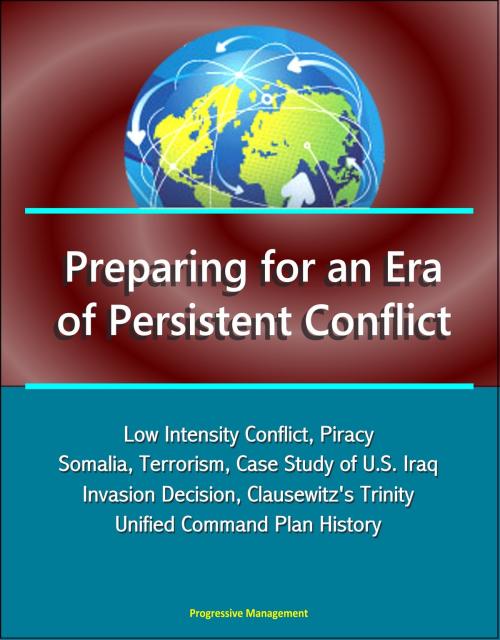Preparing for an Era of Persistent Conflict: Low Intensity Conflict, Piracy, Somalia, Terrorism, Case Study of U.S. Iraq Invasion Decision, Clausewitz's Trinity, Unified Command Plan History
Nonfiction, History, Military, Strategy| Author: | Progressive Management | ISBN: | 9781310098420 |
| Publisher: | Progressive Management | Publication: | May 31, 2014 |
| Imprint: | Smashwords Edition | Language: | English |
| Author: | Progressive Management |
| ISBN: | 9781310098420 |
| Publisher: | Progressive Management |
| Publication: | May 31, 2014 |
| Imprint: | Smashwords Edition |
| Language: | English |
U.S. Army Chief of Staff George Casey coined the phrase "era of persistent conflict" to describe the world we face in the 21st century. Adjectives abound for the future environment in which U.S forces, civilian and military, will operate in years to come: complex, uncertain, dynamic, and decentralized, to name a few. The types of operations that the men and women of the U.S. government must be prepared to conduct run the gamut from major combat operations (MCO) to counterinsurgency (COIN) to humanitarian operations. Although to some these debates and operations seem as if they have sprung from the cauldrons of Afghanistan (Operation Enduring Freedom [OEF]) and Iraq (Operation Iraqi Freedom [OIF]), they are anything but new.
This volume of papers begins with one of the central strategic issues facing the country—the lack of operational, deployable civilians. Many studies on ideal solutions to grow civilian capacity gather dust on credenzas. Until this utopian ideal is realized, however, the United States desperately needs to fill this gap with civilians trained, organized, and equipped to operate in these environments alongside their military counterparts, as Christie LaPlume writes in chapter one, "Plugging the Gap: A Comparative Review of Variables that Affect Civilian Deployment Capacity." LaPlume's innovative research took her to seven civilian agencies that currently deploy to war zones in an attempt to identify best practices that can be immediately implemented. For her outstanding efforts, LaPlume received MCWAR's 2010 best paper award.
Chapter two by John C. Vara continues the exploration of civilian capacity, specifically by assessing and proposing alternatives to the State Department's Office of the Coordinator for Reconstruction and Stabilization (S/CRS). The organizational analysis continues with Doug M. Hammer's call to establish a U.S. Stability Operations Command in chapter three. Harvey R. Robinson and Matthew G. St. Clair then examine missions that have new import yet historical roots in chapters four and five, on security force assistance and anti-piracy operations, respectively. Fritz W. Pfeiffer's chapter six uses Carl von Clausewitz's trinity (emotion, chance, reason) to look at strategic decision-making in this era of persistent conflict, using the decision to go to war in Iraq in 2003 as a case study. The book concludes with Roger R. Laferriere's call for a National Risk Communications Strategy that would ultimately make the U.S. population more resilient to future attack in this era of persistent conflict. Laferriere's groundbreaking analysis earned him MCWAR's 2009 best paper award.
Preparing for an Era of Persistent Conflict * Chapter One: Plugging in the Gap: A Comparative Review of Variables that Affect Civilian Deployment Capacity * Chapter Two: National Security and the Interagency Enterprise: A Critical Analysis * Chapter Three: Establishing U.S. Stability Operations Command: An Organization for the Critical National Security Missions of the 21st Century * Chapter Four: The Strategic Impact of the Security Assistance Program in Contingency Operations * Chapter Five: Piracy: A Local Threat with Global Impact * Chapter Six: Clausewitz's Trinity and Strategic Decision-Making * Chapter Seven: The Case for a National Risk Communications Strategy for Mitigating Terrorist Attacks
Topics and subjects covered include: Low intensity conflict (LIC), MCO, MOOTW, COIN, interagency process, Clausewitz's trinity, piracy, Somalia, al-Shabab, al-Qaeda, Terrorism, Case study of U.S. Iraq invasion decision, risk communications, chronological history of unified command plan.
U.S. Army Chief of Staff George Casey coined the phrase "era of persistent conflict" to describe the world we face in the 21st century. Adjectives abound for the future environment in which U.S forces, civilian and military, will operate in years to come: complex, uncertain, dynamic, and decentralized, to name a few. The types of operations that the men and women of the U.S. government must be prepared to conduct run the gamut from major combat operations (MCO) to counterinsurgency (COIN) to humanitarian operations. Although to some these debates and operations seem as if they have sprung from the cauldrons of Afghanistan (Operation Enduring Freedom [OEF]) and Iraq (Operation Iraqi Freedom [OIF]), they are anything but new.
This volume of papers begins with one of the central strategic issues facing the country—the lack of operational, deployable civilians. Many studies on ideal solutions to grow civilian capacity gather dust on credenzas. Until this utopian ideal is realized, however, the United States desperately needs to fill this gap with civilians trained, organized, and equipped to operate in these environments alongside their military counterparts, as Christie LaPlume writes in chapter one, "Plugging the Gap: A Comparative Review of Variables that Affect Civilian Deployment Capacity." LaPlume's innovative research took her to seven civilian agencies that currently deploy to war zones in an attempt to identify best practices that can be immediately implemented. For her outstanding efforts, LaPlume received MCWAR's 2010 best paper award.
Chapter two by John C. Vara continues the exploration of civilian capacity, specifically by assessing and proposing alternatives to the State Department's Office of the Coordinator for Reconstruction and Stabilization (S/CRS). The organizational analysis continues with Doug M. Hammer's call to establish a U.S. Stability Operations Command in chapter three. Harvey R. Robinson and Matthew G. St. Clair then examine missions that have new import yet historical roots in chapters four and five, on security force assistance and anti-piracy operations, respectively. Fritz W. Pfeiffer's chapter six uses Carl von Clausewitz's trinity (emotion, chance, reason) to look at strategic decision-making in this era of persistent conflict, using the decision to go to war in Iraq in 2003 as a case study. The book concludes with Roger R. Laferriere's call for a National Risk Communications Strategy that would ultimately make the U.S. population more resilient to future attack in this era of persistent conflict. Laferriere's groundbreaking analysis earned him MCWAR's 2009 best paper award.
Preparing for an Era of Persistent Conflict * Chapter One: Plugging in the Gap: A Comparative Review of Variables that Affect Civilian Deployment Capacity * Chapter Two: National Security and the Interagency Enterprise: A Critical Analysis * Chapter Three: Establishing U.S. Stability Operations Command: An Organization for the Critical National Security Missions of the 21st Century * Chapter Four: The Strategic Impact of the Security Assistance Program in Contingency Operations * Chapter Five: Piracy: A Local Threat with Global Impact * Chapter Six: Clausewitz's Trinity and Strategic Decision-Making * Chapter Seven: The Case for a National Risk Communications Strategy for Mitigating Terrorist Attacks
Topics and subjects covered include: Low intensity conflict (LIC), MCO, MOOTW, COIN, interagency process, Clausewitz's trinity, piracy, Somalia, al-Shabab, al-Qaeda, Terrorism, Case study of U.S. Iraq invasion decision, risk communications, chronological history of unified command plan.















